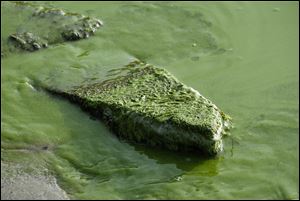
Justice Department: Judge has no authority to enforce TMDL in Lake Erie
7/11/2018One day before Gov. John Kasich announced an executive order for Lake Erie that critics claim was written to appease Ohio’s powerful agricultural lobby, the U.S. Department of Justice was making a case in federal court in Toledo for why it believes the state should not be required to impose what is seen as the most aggressive strategy for cracking down on the farming industry’s algae-forming pollution.

Algae washes ashore at the end of 113th Street in Point Place, Wednesday, Sept. 20, 2017.
Under Mr. Kasich’s order, the Ohio Soil and Water Conservation Commission will be told to designate eight watersheds or portions of watersheds with high phosphorous levels within the Maumee River Basin it considers to be the most in distress because of algae-forming phosphorus pollution. That will require more specific management plans for how manure is applied to those areas.
But although Ohio Department of Agriculture Director David Daniels believes the affected watersheds will cover more than 40 percent of western Lake Erie’s watershed, a large contingent of environmentalists, fishermen, and public policy officials continue to push for what’s known as a TMDL program.
That type of program, which stands for “total maximum daily load,” resembles something closer to a worst-case scenario for agriculture. Though present at numerous smaller watersheds around the country, including Ohio, it is extremely complex for large bodies of water such as western Lake Erie. The Chesapeake Bay’s controversial TMDL program, the nation’s largest, has generated several lawsuits by farmers there.
On Tuesday, the Justice Department filed a 21-page motion in U.S. District Court in Toledo, claiming Judge James Carr has no authority to make the U.S. Environmental Protection Agency force the state of Ohio into doing a TMDL for western Lake Erie.
The Justice Department also claimed Judge Carr should declare the case brought against the agency moot and step down from it now that the Kasich administration — after years of resistance on behalf of agriculture — reluctantly designated Lake Erie as impaired in March.
Ohio EPA Director Craig Butler has said several times the Kasich administration did not start planning for a TMDL immediately after making the impairment designation because it was not sure how that would be done for Lake Erie.
Lawyers for both the U.S. Department of Justice and the Environmental Law & Policy Center have agreed that setting up a TMDL for Lake Erie would take months, possibly years. The whole region would be placed under a so-called “pollution diet,” meaning releases of phosphorus, nitrogen, and other nutrients would be specifically capped on a site-by-site basis, depending on how many nutrients the lake could reasonably expect to endure without growing excessive algae, with tough violations for non-compliance.
In their new filing, Justice attorneys Jeffrey Wood and Daniel Dertke, as well as U.S. Attorney Justin Herdman and Assistant U.S. Attorney Jody King, argue the state of Ohio never overtly stated it would refuse to do a TMDL, and that the U.S. EPA never ruled out the possibility of ordering it to do one.
“Ohio has neither abandoned its obligation to produce a TMDL for western Lake Erie, nor has Ohio refused to develop a TMDL,” they wrote.
Therefore, the government attorneys claim, a recent motion the ELPC filed for a TMDL should be dismissed. And, they continued, if Judge Carr dismisses the ELPC’s motion, then he should dismiss the case because there are no other matters before the judge now that the impairment designation’s been made.
The case was originally brought over the lack of an impairment designation. Toledo-based Advocates for a Clean Lake Erie is a co-plaintiff with the ELPC.
Though Ohio has never explicitly stated it would refuse to do a TMDL, Karl Gebhardt, Ohio EPA deputy director for water resources and one of the Kasich administration’s key players on Lake Erie issues, said at the Ohio Lake Erie Commission’s April meeting the administration’s “position is a TMDL still is not necessary for the lake.”
“It would take a considerable amount of time and would generate many lawsuits similar to what happened in the Chesapeake Bay,” Mr. Gebhardt, the commission’s executive director and a former Ohio Farm Bureau lobbyist, said at that meeting.
The ELPC attorney handling the lawsuit, Madeline Fleisher, has said the federal Clean Water Act requires TMDLs to be set up once bodies of water are designated as impaired, an opinion sharply rebuked by the four government attorneys in their new filing.
The government attorneys claim the lawsuit brought by the ELPC and ACLE is even more moot now, because Ohio kept the open waters of Lake Erie on its 2018 list of impaired waters it submitted to the U.S. EPA on June 1. The federal agency approved that list on July 9, meaning it supersedes what was on the amended 2016 list where Lake Erie was designated as impaired in March.
The case is scheduled to be back before Judge Carr in open court on Aug. 21.
Contact Tom Henry at thenry@theblade.com, 419-724-6079, or via Twitter @ecowriterohio.